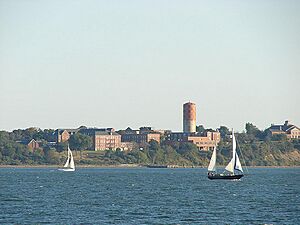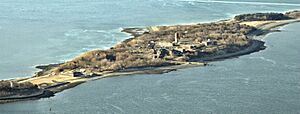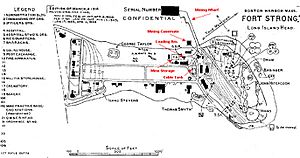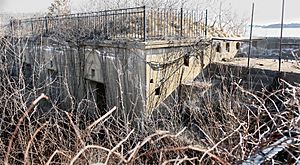Long Island (Massachusetts) facts for kids
Long Island is an island located in Boston Harbor, Massachusetts. It is part of the City of Boston and the Boston Harbor Islands National Recreation Area. The island is about 1.75 miles (2.8 km) long and covers 225 acres (0.91 km²).
Before October 2014, you could reach the island by driving over a long road called a causeway. This causeway connected the Squantum peninsula in North Quincy to Moon Island. From Moon Island, a bridge called the Long Island Viaduct led to Long Island. Access to this road was controlled by police, and you needed special permission to go there because it was a restricted area.
In October 2014, the bridge to Long Island was closed because it was unsafe. The Mayor of Boston, Marty Walsh, made this decision based on warnings from the Massachusetts Department of Transportation. Everyone living on Long Island, including people in recovery programs and a homeless shelter, had to move quickly. The bridge was later taken down on March 23, 2015. The future of the island and its buildings is still being discussed.
Contents
History of Long Island
Early Days: The 1600s
When the first European settlers arrived, Native American Indians lived on and used Long Island. On April 1, 1634, the island was given to the City of Boston. The city also received Deer Island and Hogg Island (now part of East Boston). The yearly rent for these islands was two pounds. Later, Spectacle Island was added, and the rent for all four islands was lowered to four shillings per year.
The Town of Boston rented out Long Island to 37 tenant farmers. They used the land for farming and cutting down trees. Wood was very important back then for cooking and heating homes in Boston. Long Island got its name because it is long—about 1.75 miles long and a quarter mile wide. An early writer, William Wood, said the island had lots of wood, water, and good farming land. Farmers also kept their animals like rams, goats, and pigs there to keep them safe during the corn growing season.
In 1640, Boston decided to divide Long Island into smaller farming plots. A year later, a man named William, Earl of Stirling, tried to claim ownership of the island, but the court in Boston found his claim had no basis.
In 1649, the court in Boston set a yearly rent of 6 pence per acre for the farms on Long Island. This money was meant to help support the Boston Latin School, which was a free school. However, the farmers on Long Island refused to pay. So, in 1655, Boston officials sent a constable to collect the money.
By 1667, Boston officially gave the farms on Long Island to the tenants. This meant the land became privately owned for the first time. In 1672, Joseph and Elizabeth Rock bought 41 acres (0.17 km²) on the island. Their property included houses, barns, wharfs, gardens, and fishing rights.
During King Philip's War in the 1670s, many Christian "praying Indians" were moved from their homes. Most were sent to Deer Island, but some were also sent to Long Island. In 1676, during a time of fear from the war, many Native Americans were gathered from nearby towns and taken to Deer Island. They were left there during a very cold winter with little food or shelter. Many Native Americans died from hunger and cold. In the spring of 1677, the Native Americans who survived were allowed to move to Long Island.
On April 19, 1689, a Long Island resident named John Nelson led a revolt in Boston against Governor Sir Edmund Andros. Governor Andros had taken away many of the colony's laws and agreements.
In 1690, John Nelson bought almost all the property on Long Island from the tenants. Nelson was a well-known person with important family connections. He later mortgaged his Long Island property for 1,200 pounds. In 1692, Nelson was captured by the French while on a privateering trip and imprisoned in Quebec. He learned about secret French plans to attack the Massachusetts colonies and secretly warned the authorities. For this, he was sent to a prison in France. After ten years, he was released and returned home to Long Island, which was sometimes called Nelson's Island. He was seen as a local hero.
The 1700s: New Owners and War
After John Nelson died in 1721, ownership of Long Island went to his heirs. In 1724, the island's ownership officially returned to Nelson's family. Later, Robert Temple and the other owners sold the entire island to Charles Apthorp, a merchant from Boston. The island was then sometimes called Apthorp's Island. Charles Apthorp died in 1758, and his family sold the island to Barlow Trecothick, who later became the Lord Mayor of London.
During the American Revolutionary War in 1768, British soldiers used Long Island to graze their sheep, cattle, and pigs. They also harvested hay from the island to feed their horses in Boston.
On July 12, 1775, American soldiers led by Colonel John Greaton raided Long Island. They took all the sheep and cattle and captured 17 British sailors who were guarding the animals. British warships fired at the American boats, and one American soldier was killed on Moon Island.
On March 17, 1776, British ships left Boston because George Washington's forces had taken control of Dorchester Heights. However, the British ships stayed in the outer harbor for three more months, blocking Boston Harbor. This worried the people of Boston.
On June 13, 1776, American General Ward ordered soldiers to set up cannons on the East Head of Long Island. This place was called "Long Island Battery." When the American cannons fired, they hit the British flagship, "Milford," and the British fleet left the harbor.
During this time, two American privateer ships attacked a British transport ship called "Arbella." The Arbella was carrying supplies and Scottish soldiers. The American ships captured the Arbella after a fight. The Scottish soldiers who died in the battle were buried on Long Island in a special ceremony with Scottish bagpipers. The valuable military supplies from the ship were quickly sent to the American army in Cambridge.
On July 17, 1776, the Long Island Battery fired a 13-gun salute to celebrate the Declaration of Independence. Other forts in Boston Harbor also fired salutes.
A story is told about Mary Burton, a woman whose husband was a loyalist (someone who supported the British). She was on a British ship during the blockade. A cannonball from Long Island Battery hit her. As she was dying, she asked her husband not to bury her at sea. He was allowed to go ashore and bury her on East Head. People later built a stone pile over her grave. There are stories of a "woman in scarlet" ghost seen on the island years later.
Barlow Trecothick, the owner of Long Island, died in 1775. The island was sold to James Ivers of Boston in 1791. Around this time, the island officially became known as Long Island. In 1794, a lighthouse was built on the northern part of the island to help ships navigate.
The 1800s: Lighthouses and Development
During the War of 1812, in 1814, military leaders suggested that Long Island should be fortified to prevent the British from entering Boston Harbor.
In 1818, a group looked into building a lighthouse on Long Island Head to help ships coming into Boston Harbor. The first lighthouse on Long Island Head was built in 1819. It was a 23-foot (7 m) stone tower, and its light could be seen for about 15 miles (24 km). This light, called the "Inner Harbor Light," was the second lighthouse in Boston Harbor.
In 1825, the lighthouse keeper, Charles Beck, started a signal system. He would raise a black ball to show when more ship pilots were needed in the harbor. This system was used until 1851.
In the 1830s, Long Island was seen as a beautiful place for a summer resort. A hotel, called the Long Island Hotel, was built. However, by 1840, the island's popularity for resorts faded.
In 1844, a new cast-iron lighthouse was built on Long Island Head. This was the first cast-iron lighthouse ever built in the United States! It was made in sections and had a circular staircase inside.
In 1847, the owners sold Long Island to Thomas Smith, but the part with the lighthouse was not included. There were plans to develop the island, but rumors that the City of Boston wanted to buy it for its institutions made investors hesitant.
In 1849, the Long Island Company bought the island. At this time, only a farmer and a Portuguese fisherman lived there. Over the next 35 years, the fisherman's family and friends grew the population to over 30 families, creating a "Portuguese Village" near East Head.
The Long Island Company built the Long Island House and the Long Island Hotel to attract visitors. The hotel was described as a "splendid hotel" shaped like a Greek Cross. The island was mostly meadows and grazing fields, as many trees had been cut down for firewood.
In 1855, the second Long Island Light was updated with a new lens that made its light visible towards Broad Sound. A comfortable stone house was built for the lighthouse keeper.
American Civil War and Beyond
In 1860, the Long Island Company was taken over by Thomas J. Dunbar. Plans to develop the island were stopped by the threat of the American Civil War. Camp Wightman was set up on Long Island as a military post. General Devens used the Long Island House as his headquarters. In 1861, the 3rd Massachusetts Regiment and the 4th Massachusetts Regiment left Long Island to fight in Virginia. These regiments were known for destroying the navy yard at Norfolk, Virginia, and fighting at Hampton. They were among the first northern troops to march on Virginia soil.
By 1863, Camp Wightman had over 1,000 new soldiers and many heavy artillery units. The military area was located between the Portuguese Village and the Long Island House.
After the Civil War, in 1867, the U.S. government bought the East Head section of Long Island. Fort Strong was moved there from another island. The fort was named after Major General George C. Strong.
In 1869, a big storm (likely a hurricane) hit Boston Harbor, damaging the lighthouse keeper's house and boathouse on Long Island.
In 1870, a 10-gun battery was built at Fort Strong. In 1872, a large hotel was built on the site of what is now the Long Island Chronic Disease Hospital.
Long Island also became a place for illegal activities, like prize fighting. In 1873, the Boston Police raided the island to stop these events.
In 1881, a new cast-iron lighthouse was built, along with a new keeper's house. This was the third lighthouse on Long Island Head.
In 1882, the City of Boston began buying property on Long Island for public care facilities. These included an Almshouse (a place for poor people), a residence for unwed mothers, a hospital for long-term illnesses, a nursing school, and a farm. The large hotel built in 1872 was used for city charities. In 1882, male paupers were moved to Long Island from another island.
On January 3, 1885, the Boston City Council officially took possession of Long Island. It has been public land ever since. Buildings were immediately built for a "Home for the Indigent," housing 650 people in 1885.
Modern Fort Strong Development
In 1893, a huge construction project began to build large concrete gun placements for five 10-inch guns at Fort Strong. This was part of a plan to improve coastal defenses across the United States. These large gun positions are still visible today on the northern part of the island. Work continued on smaller 3-inch gun positions until 1906.
Fort Strong was equipped with the latest artillery. It had seven new batteries of 3-inch, 4.7-inch, and 10-inch guns along three sides of the island. It also had facilities for placing and retrieving underwater mines that protected the harbor channels. Barracks were built for over 1,000 soldiers who served at the fort.
Long Island Head was in the center of Boston Harbor. The fort's large 10-inch guns could reach far distances, covering areas like Revere to the north and Hingham to the south, and well out into the sea.
Before World War II, the fort controlled all the underwater mines that protected the southern parts of Boston Harbor. The fast-firing 3-inch guns on the fort's shores were there to destroy any attacking ships that got caught in the minefields.
By World War II, only some of the 3-inch guns and anti-aircraft cannons were still in use. After the war, the fort was no longer needed. In the 1950s, buildings for the Nike missile system (which is no longer used) were built on the island. A radar for tracking targets was also built in one of the old gun positions.
The 1900s: Social Services and Community

In 1928, homeless men were housed in an addition to the former hotel. In 1941, another addition became a treatment center. New dormitories for men, called the Tobin building, were built and named after Maurice J. Tobin, who was then the Mayor of Boston.
By 1941, Long Island had Boston's almshouse and a Chronic Disease Hospital. About 1,400 patients and residents lived on the island, cared for by hundreds of doctors, nurses, and staff.
Until the 1950s, the only way to get to the island was by boat or ferry. Then, a bridge was built from Moon Island to Long Island. Moon Island is connected to the mainland by a causeway.
Recent Use and Closure
Long Island was used for social service programs from 1882 until 2014. These programs were run by the Boston Public Health Commission.
Many buildings on the island are now empty but were once very busy. These include the Curley Building, which had an auditorium, and Our Lady of Hope Chapel. Most of the campus buildings were connected by tunnels.
The Boston Fire Department's Engine Company 54 also had a station house on the island.
You can find historical buildings and cemeteries on the island, dating from the Civil War to the Cold War. There's also a large red and white checkered water tower that pilots use as a navigation aid for Logan International Airport.
There was also a working organic farm on the island, which was 2 acres (0.0081 km²) large. It grew about 25,000 pounds (11,340 kg) of fresh produce each year. This food was used in the homeless shelters' kitchens, sold at farmers' markets, and used by restaurants in Boston. Residents of Long Island worked on the farm. This idea came from Mayor Thomas Menino in 1996.
In 2007, Mayor Thomas Menino also helped start a summer day camp for teenagers called Camp Harbor View. This camp was a partnership between Boston, the Boys & Girls Clubs of Boston, and a non-profit foundation. Camp Harbor View opened in March 2007 and had baseball fields, swimming, classrooms, and many other activities. About 900 campers attended each summer. It was located where the old marching grounds were, south of Fort Strong and the lighthouse.
Evacuation and What Happened Next
On October 8, 2014, Mayor Marty Walsh decided to close the Long Island Bridge and move all the programs from Long Island. This decision was made because the bridge was unsafe after years of not being properly maintained.
In 2016, the organic farm, which had been worked by homeless clients for many years, was reopened for a private fast-food restaurant chain. This company plans to return some of the crops to help charities.
Buildings and Structures
Here is a list of some buildings and structures on Long Island:
- Buildings
- Former Nike missile facilities (two buildings; empty)
- Department of Environmental Protection and Boston Edison Air Monitoring Stations
- Farm and greenhouse
- Laundry building
- Garage
- Fire house
- (Mary) Morris building
- Curley recreation building (empty)
- Tobin building
- McGillivray building
- Wards A B C D
- Richards building
- Laboratory and morgue (empty)
- Incinerator (behind morgue - empty)
- Power house
- Administration building
- Nichols building
- Our Lady of Hope Chapel (not used)
- Building 6 (empty)
- Nurses Building (empty)
- Sewage treatment plant
- Fort Strong power house, incinerator, and tower
- Long Island Head Light
- Fortifications
- Fort Strong: Battery Ward, Battery Hitchcock, Battery Drum, Battery Basinger, Battery Smyth, Battery Taylor, Battery Stevens.
- Other structures
- Viaduct (bridge; not open to public)
- Pier (not open to public)
- Civil War monument and cemetery
- Hospital cemetery (3,000 graves)
- Unmarked cemetery
- Water tower
- MWRA (Massachusetts Water Resources Authority) shaft
- Grotto Shrine of Our Lady of Fatima. It was once next to the older demolished original chapel building.
Images for kids
See also
- Green Island (Massachusetts)
- Great Brewster
- Little Brewster
- Middle Brewster
- Outer Brewster
- Tewksbury Rock (Massachusetts)








